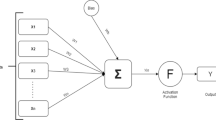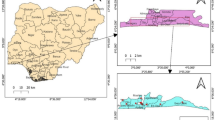Abstract
Short-term load forecasting in power system is an important factor planning and electricity marketing. Due to the uncertainty of the load demand, many studies have been devised for nonlinear prediction methods. In this paper, a hybrid approach consisting of support vector regression (SVR) and social spider optimization (SSO) is proposed for short term load forecasting. The SVR technique has proven to be useful in nonlinear forecasting problems. To improve accuracy of SVR parameters are tuned using SSO. The SSO algorithm is based on the simulation of cooperative behavior of social-spiders and helps in achieving good results.








Similar content being viewed by others
References
Fan S, Chen L (2006) Short-term load forecasting based on an adaptive hybrid method. IEEE Trans Power Syst 21(1):392–401
Bunn DW (2000) Forecasting loads and prices in competitive power markets. Proc IEEE 88(2):163–169
Gonzalez-Romera E, Jaramillo-Moran MA, Carmona-Fernandez D (2006) Monthly electric energy demand forecasting based on trend extraction. IEEE Trans Power Syst 21(4):1946–1953
Cortes C, Vapnik V (1995) Support-vector networks. Machine learning 20(3):273–297
Bermolen P, Rossi D (2009) Support vector regression for link load prediction. Comput Netw 53(2):191–201
Kavousi-Fard A, Samet H, Marzbani F (2014) A new hybrid modified firefly algorithm and support vector regression model for accurate short term load forecasting. Expert Syst Appl 41(13):6047–6056
Selakov A, Cvijetinović D, Milović L, Mellon S, Bekut D (2014) Hybrid PSO–SVM method for short-term load forecasting during periods with significant temperature variations in city of Burbank. Applied Soft Computing 16:80–88
Hu Z, Bao Y, Xiong T (2014) Comprehensive learning particle swarm optimization based memetic algorithm for model selection in short-term load forecasting using support vector regression. Applied Soft Computing 25:15–25
Foelix R (1996) Biology of Spiders. Oxford Univ. Press, Oxford
Cuevas E, Cienfuegos M, Zaldívar D, Pérez-Cisneros M (2013) A swarm optimization algorithm inspired in the behavior of the social-spider. Expert Syst Appl 40(16):6374–6384
Cuevas E, Cienfuegos M (2014) A new algorithm inspired in the behavior of the social-spider for constrained optimization. Expert Syst Appl 41(2):412–425
Dorigo M, Bonabeau E, Theraulaz G (2000) Ant algorithms and stigmergy. Future Generation Computer Systems 16(8):851–871
Abbaspour K, Schulin R, Van Genuchten MT (2001) Estimating unsaturated soil hydraulic parameters using ant colony optimization. Adv Water Resour 24(8):827–841
Simpson A, Maier H, Foong W, Phang K, Seah H, Tan C (2001) Selection of parameters for ant colony optimization applied to the optimal design of water distribution systems. In: Proc. Int. Congress on Modeling and Simulation, Canberra, Australia, pp. 1931–1936
Fisher ML (1981) The Lagrangian relaxation method for solving integer programming problems. Manag Sci 27(1):1–18
Smola AJ, Schölkopf B (2004) A tutorial on support vector regression. Stat Comput 14(3):199–222
Karush W (1939) Minima of functions of several variables with inequalities as side conditions, Master thesis, University of Chicago
Kuhn H, Tucker A (1951) Nonlinear programming. Sid 481–492 i Proc. of the second Berkeley Symposium on mathematical statistics and probability.Univ. of California Press
Efendi R, Ismail Z, Deris MM (2015) A new linguistic out-sample approach of fuzzy time series for daily forecasting of Malaysian electricity load demand. Appl Soft Comput 28:422–430
Vapnik V (2013) The nature of statistical learning theory. Springer science & business media, Berlin
Gunn SR (1998) Support vector machines for classification and regression. ISIS technical report 14:85–86
Schölkopf B, Burges CJ, Smola AJ (1999) Advances in kernel methods: support vector learning. MIT press, Cambridge
Mirza M, Sommers J, Barford P, Zhu X (2007) A machine learning approach to TCP throughput prediction. ACM SIGMETRICS Perform Evaluat Rev 35(1):97–108 (ACM)
Ruping S, Morik K (2003) Support vector machines and learning about time. In: Acoustics, Speech, and Signal processing, 2003. Proceedings.(ICASSP’03). 2003 IEEE international conference on, 2003, vol. 4, pp. IV-864: IEEE
James J, Li VO (2015) A social spider algorithm for global optimization. Applied Soft Comput 30:614–627
Peters JF (2014) Topology of digital images: visual pattern discovery in proximity spaces. Springer, Berlin
Son H, Kim C (2015) Forecasting short-term electricity demand in residential sector based on support vector regression and fuzzy-rough feature selection with particle swarm optimization. Procedia Eng 118:1162–1168
Nadtoka I, Balasim MA-Z (2015) Mathematical modelling and short-term forecasting of electricity consumption of the power system, with due account of air temperature and natural illumination, based on support vector machine and particle swarm. Procedia Eng 129:657–663
Ceperic E, Ceperic V, Baric A (2013) A Strategy for Short-Term Load Forecasting by Support Vector Regression Machines. IEEE Trans Power Syst 28(4):4356–4364
Laouafi A, Mordjaoui M, Laouafi F, Boukelia TE (2016) Daily Peak Electricity Demand Forecasting Based on an Adaptive Hybrid Two-Stage Methodology. Int J Electr Power Energy Syst 77:136–144
Juan H, Tingting S, Jing C (2016) Comparison of random forest and SVM for electrical short-term load forecast with different data sources. In: 2016 7th IEEE International conference on software engineering and service science (ICSESS)
Author information
Authors and Affiliations
Corresponding author
Additional information
Publisher's Note
Springer Nature remains neutral with regard to jurisdictional claims in published maps and institutional affiliations.
Rights and permissions
About this article
Cite this article
Sina, A., Kaur, D. Short Term Load Forecasting Model Based on Kernel-Support Vector Regression with Social Spider Optimization Algorithm. J. Electr. Eng. Technol. 15, 393–402 (2020). https://doi.org/10.1007/s42835-019-00135-8
Received:
Revised:
Accepted:
Published:
Issue Date:
DOI: https://doi.org/10.1007/s42835-019-00135-8




